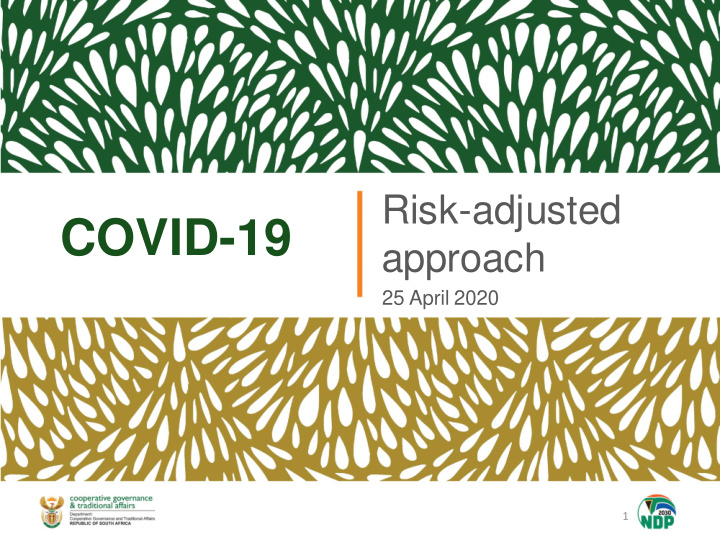



Risk-adjusted COVID-19 approach 25 April 2020 1
INTRODUCTION ▪ The COVID-19 crisis presents an unprecedented challenge, unmatched since the Spanish Flu and the Great Depression. The latter decimated over 300 000 South Africa’s Population. ▪ Feeling overwhelmed? Approach coronavirus as a challenge to be met, not a threat to be feared” – Bethany Teachman ▪ It also presents an opportunity for South Africa to accelerate the implementation of some long agreed-upon structural changes to enable reconstruction and growth. ▪ These will positively impact on key economic and social sectors which will facilitate a more inclusive economy whilst unlocking local production and export potential. ▪ This will require that South Africa sequences and phases its priority areas with a view to deepening the fight against COVID-19 whilst rebuilding the economy. 2
INTRODUCTION ▪ The risk-adjusted approach was developed through collaboration between the economic cluster departments and the Department of Health. We have taken into account comments made by business organisations, political parties, union and commentators. ▪ This proposal takes into account the advice of the Ministerial Advisory Committee that the high-point of the virus spread is likely to be in September, which requires a proposal that covers the next 6-8 months. 3
4
THREE SYSTEMS ARE ENVISAGED. • SYSTEM 1 An alert system to determine the level of restrictions in place nationally, in provinces and in districts • SYSTEM 2 An industry classification for readiness to return at each level based on criteria, together with restrictions that should remain after the lockdown regardless of the alert level • SYSTEM 3 Enhanced public health and social distancing arrangements at workplaces and public spaces (including schools and Higher Education institutions that may reopen during the pandemic period) 5
SYSTEM 1 Alert system for the country, provinces and districts High virus spread and/or low health Full lockdown Level 5 system readiness Moderate to high virus spread with low to High restrictions Level 4 moderate readiness Moderate virus spread with moderate Moderate restrictions Level 3 readiness Moderate virus spread with high Level 2 Reduced restrictions readiness Level 1 Low virus spread with high readiness Minimum restrictions 6
SYSTEM 1 Alert system for the country, provinces and districts On what basis will the alert level be determined? ▪ For community transmission, two indicators are considered: • Rate at which the proportion of the population tested (testing coverage) is increasing (higher is better) • Rate at which the proportion of positive tests is increasing (lower is better) ▪ For health care capacity, two further indicators are considered: • Rate of increase in fixed and makeshift hospital beds in both public and private sectors per 1000 population (higher is better) • Rate at which the proportion of hospital beds being utilized for Covid-19 is increasing (lower is better) ▪ All 4 measures are measures that change over time ie. They are not static measures but rather they are dynamic changes occurring over a period of time (eg. per week) and will influence the level at which the country, a province or a district will be classified. 7
SYSTEM 2 Industry classification for readiness to return at each alert level In order to identify and sequence the possible priority economic areas which will require easing post the lockdown period, an alert system has been developed which considers the following criteria: (1) Risk of transmission (2) Expected impact on the sector should the lockdown continue; (3) Value (and economic linkages) of the sector to the broader economy (including its contribution to the GDP, employment, multiplier effects, its export earnings, supply-chain linkages and industrial policy goals); and (4) The promotion of community wellbeing and the livelihoods of the most vulnerable Initially, return to work will be based on the national level, but will progressively be expanded to provincial and district level, enabling workplaces to adapt to the level of infection and healthcare readiness in their locality. 8
SYSTEM 3: ENHANCED PUBLIC HEALTH A comprehensive system of public health and social-distancing arrangements will be put in place, covering areas such as the following: ▪ Industries are encouraged to adopt a work-from-home strategy where possible, and all staff who can work remotely must be allowed to do so. ▪ Workers above the age of 60, as well as workers with comorbidities, should be offered a work-from-home option or remain on leave after engagement with employers and the UIF. ▪ Workplace protocols to be in place that would include disease surveillance and prevention of the spread of infection, disabling contact biometric systems or making them Covid-proof ▪ Guidelines will be developed for public servants as well as correctional facilities. 9
CONDITIONS OF RETURN TO WORKPLACE: SECTOR ▪ In addition to generally applicable health and safety protocols, each sector must agree upon a COVID-19 prevention and mitigation plan, approved by the Minister of Health and any other Minister relevant to the sector. ▪ Individual businesses or workplaces must have COVID-19 risk assessments and plans in place, and must conduct worker education on COVID-19 and protection measures: • Identification and protection of vulnerable employees • Safe transport of employees • Screening of employees on entering the workplace • Prevention of viral spread in the workplace • Hand sanitisers and face masks • Cleaning of surfaces and shared equipment • Good ventilation • Shift arrangements and canteen controls • Managing sick employees ▪ Monitoring systems must be in place to (1) ensure compliance with safety protocols and (2) identify infections among employees. ▪ Mass testing should be carried out for workplaces over 500 workers. 10
Siyabonga THANK YOU Realeboga Ro livhuwa 11
Recommend
More recommend